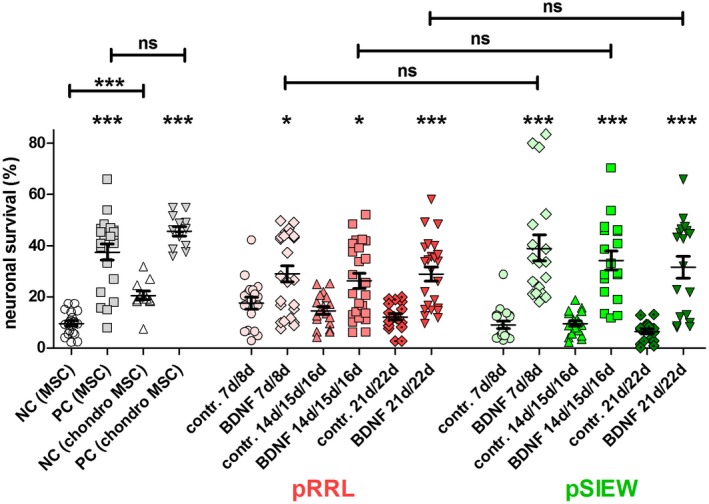Figure 5.

Neuroprotection of SGN by supernatants of pRRL‐ and pSIEW‐ infected hMSCs during chondrogenic differentiation. The mean and SEM SGN survival rate (in % related to the seeding control) of controls and of three MSC‐donors infected either with pRRL (red) or pSIEW (green) and subsequently differentiated to chondrocytes are shown. Differences between a BDNF containing (exogenous or endogenous) group and the relevant control (lacking BDNF) are depicted directly above the relevant bar. Differences between experimental conditions are indicated by horizontal line above the respective bars. The control data are depicted in gray with MSC growth medium (MSC, including 5% FCS) without any growth factor addition (negative control [NC MSC]) or with addition of recombinant BDNF (positive control [PC MSC]). A second set of positive and negative controls was added with chondrogenic differentiation medium metabolized by native MSCs (NC [chondro MSC] and PC [chondro MSC]). The positive controls significantly protected the neurons from degeneration. The metabolized chondrogenesis medium without BDNF addition (NC (chondro MSC) increased the neuronal survival significantly compared to the control using MSC‐medium. At all time points the infection with the BDNF‐lentiviruses (BDNF) achieved a BDNF‐induced neuronal protection compared to the relevant control (contr.: lentivirus without BDNF for pSIEW, luciferase instead of BDNF for pRRL), independently from the fluorescence‐marker gene used. When comparing the neuroprotective effect of the produced BDNF at a specific time point between pRRL and pSIEW‐infected hMSC no differences were observed. *p < 0.05; **p < 0.01; ***p < 0.001; ns = not significant
